2006 DODGE RAM SRT-10 ECO mode
[x] Cancel search: ECO modePage 4965 of 5267
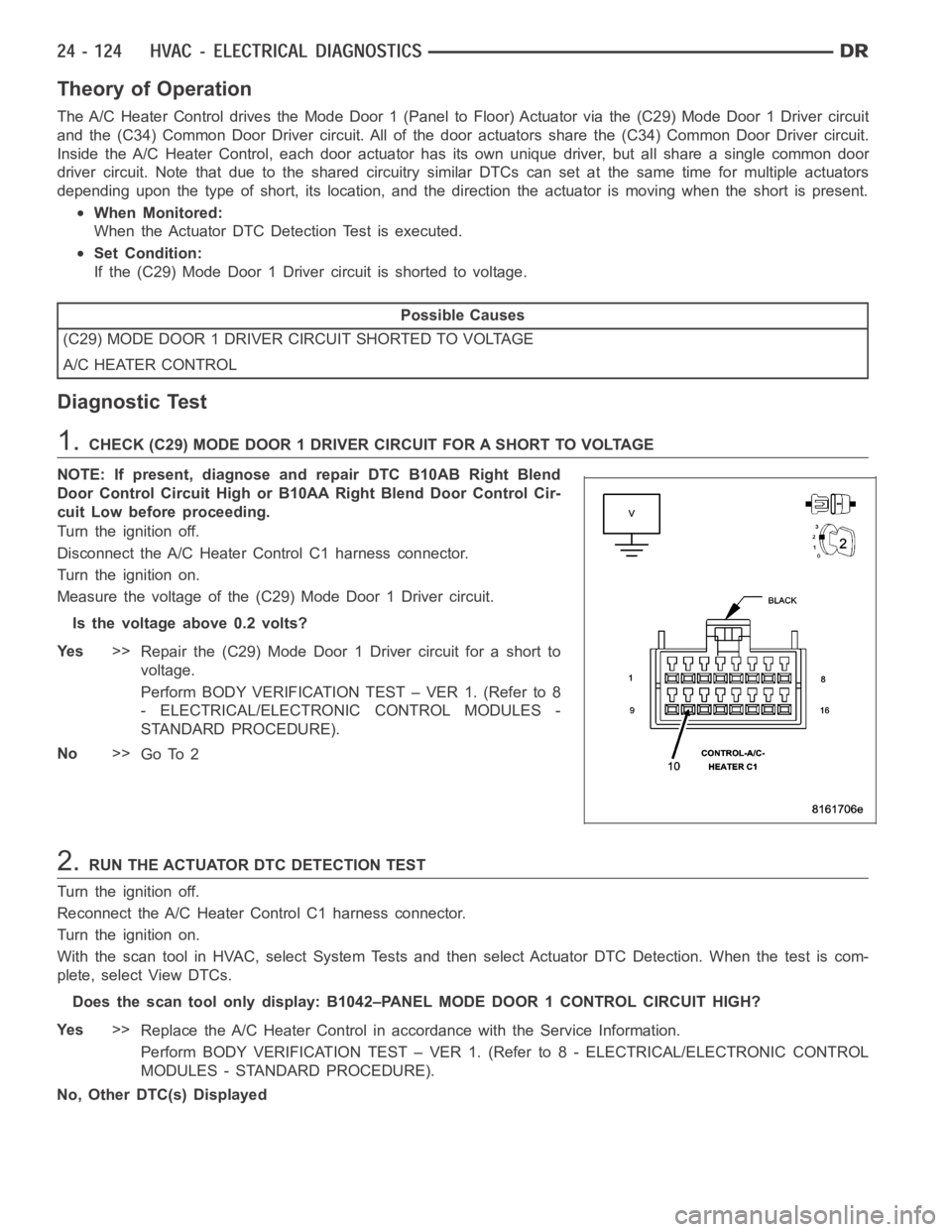
Theory of Operation
The A/C Heater Control drives the Mode Door 1 (Panel to Floor) Actuator via the (C29) Mode Door 1 Driver circuit
and the (C34) Common Door Driver circuit. All of the door actuators share the (C34) Common Door Driver circuit.
Inside the A/C Heater Control, each door actuator has its own unique driver, but all share a single common door
driver circuit. Note that due to the shared circuitry similar DTCs can set at the same time for multiple actuators
depending upon the type of short, its location, and the direction the actuator is moving when the short is present.
When Monitored:
When the Actuator DTC Detection Test is executed.
Set Condition:
If the (C29) Mode Door 1 Driver circuit is shorted to voltage.
Possible Causes
(C29) MODE DOOR 1 DRIVER CIRCUIT SHORTED TO VOLTAGE
A/C HEATER CONTROL
Diagnostic Test
1.CHECK (C29) MODE DOOR 1 DRIVER CIRCUIT FOR A SHORT TO VOLTAGE
NOTE: If present, diagnose and repair DTC B10AB Right Blend
Door Control Circuit High or B10AA Right Blend Door Control Cir-
cuit Low before proceeding.
Turn the ignition off.
Disconnect the A/C Heater Control C1 harness connector.
Turn the ignition on.
Measure the voltage of the (C29) Mode Door 1 Driver circuit.
Is the voltage above 0.2 volts?
Ye s>>
Repair the (C29) Mode Door 1 Driver circuit for a short to
voltage.
Perform BODY VERIFICATION TEST – VER 1. (Refer to 8
- ELECTRICAL/ELECTRONIC CONTROL MODULES -
STANDARD PROCEDURE).
No>>
Go To 2
2.RUN THE ACTUATOR DTC DETECTION TEST
Turn the ignition off.
Reconnect the A/C Heater Control C1 harness connector.
Turn the ignition on.
With the scan tool in HVAC, select System Tests and then select Actuator DTCDetection. When the test is com-
plete, select View DTCs.
Does the scan tool only display: B1042–PANEL MODE DOOR 1 CONTROL CIRCUIT HIGH?
Ye s>>
Replace the A/C Heater Control in accordance with the Service Information.
Perform BODY VERIFICATION TEST – VER 1. (Refer to 8 - ELECTRICAL/ELECTRONIC CONTROL
MODULES - STANDARD PROCEDURE).
No, Other DTC(s) Displayed
Page 4968 of 5267
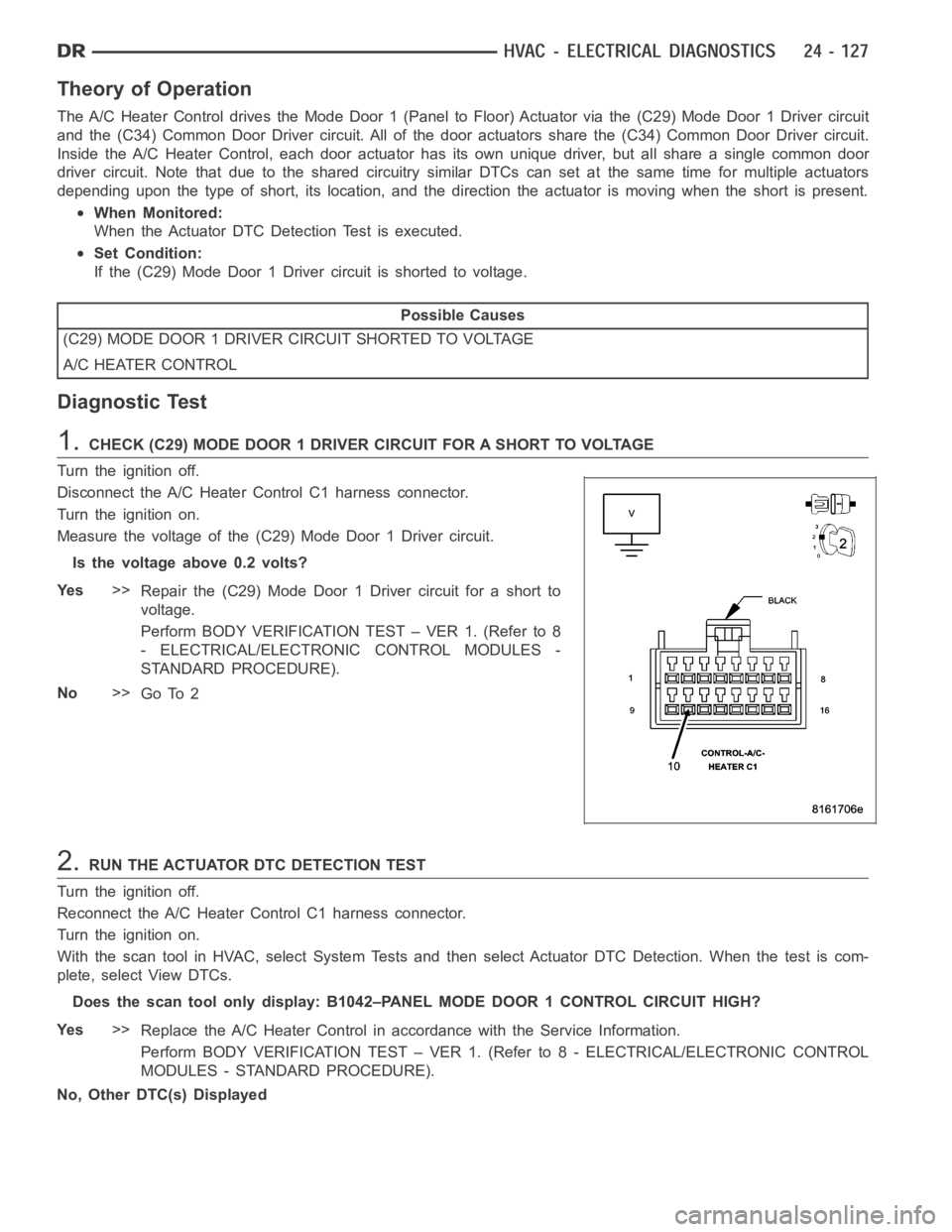
Theory of Operation
The A/C Heater Control drives the Mode Door 1 (Panel to Floor) Actuator via the (C29) Mode Door 1 Driver circuit
and the (C34) Common Door Driver circuit. All of the door actuators share the (C34) Common Door Driver circuit.
Inside the A/C Heater Control, each door actuator has its own unique driver, but all share a single common door
driver circuit. Note that due to the shared circuitry similar DTCs can set at the same time for multiple actuators
depending upon the type of short, its location, and the direction the actuator is moving when the short is present.
When Monitored:
When the Actuator DTC Detection Test is executed.
Set Condition:
If the (C29) Mode Door 1 Driver circuit is shorted to voltage.
Possible Causes
(C29) MODE DOOR 1 DRIVER CIRCUIT SHORTED TO VOLTAGE
A/C HEATER CONTROL
Diagnostic Test
1.CHECK (C29) MODE DOOR 1 DRIVER CIRCUIT FOR A SHORT TO VOLTAGE
Turn the ignition off.
Disconnect the A/C Heater Control C1 harness connector.
Turn the ignition on.
Measure the voltage of the (C29) Mode Door 1 Driver circuit.
Is the voltage above 0.2 volts?
Ye s>>
Repair the (C29) Mode Door 1 Driver circuit for a short to
voltage.
Perform BODY VERIFICATION TEST – VER 1. (Refer to 8
- ELECTRICAL/ELECTRONIC CONTROL MODULES -
STANDARD PROCEDURE).
No>>
Go To 2
2.RUN THE ACTUATOR DTC DETECTION TEST
Turn the ignition off.
Reconnect the A/C Heater Control C1 harness connector.
Turn the ignition on.
With the scan tool in HVAC, select System Tests and then select Actuator DTCDetection. When the test is com-
plete, select View DTCs.
Does the scan tool only display: B1042–PANEL MODE DOOR 1 CONTROL CIRCUIT HIGH?
Ye s>>
Replace the A/C Heater Control in accordance with the Service Information.
Perform BODY VERIFICATION TEST – VER 1. (Refer to 8 - ELECTRICAL/ELECTRONIC CONTROL
MODULES - STANDARD PROCEDURE).
No, Other DTC(s) Displayed
Page 4971 of 5267
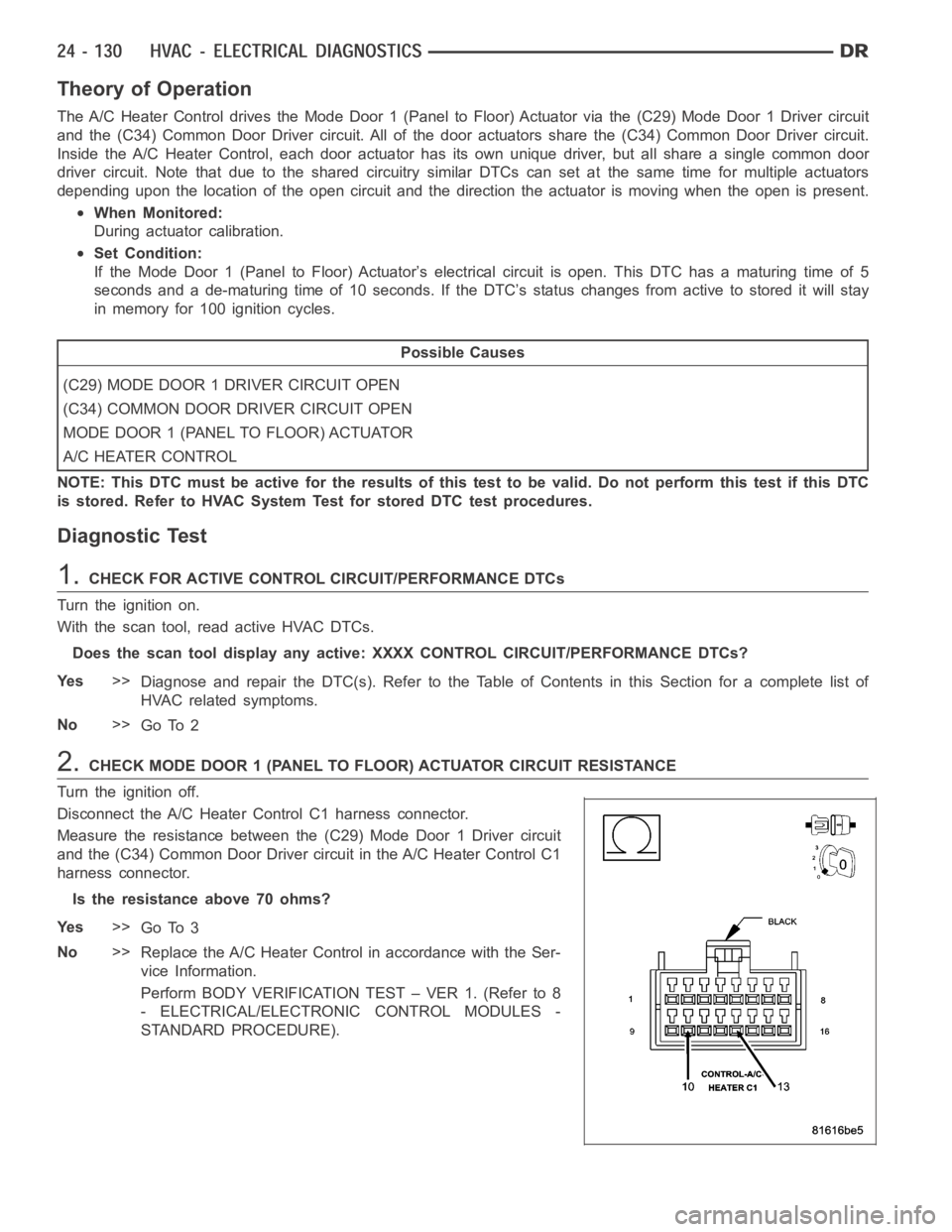
Theory of Operation
The A/C Heater Control drives the Mode Door 1 (Panel to Floor) Actuator via the (C29) Mode Door 1 Driver circuit
and the (C34) Common Door Driver circuit. All of the door actuators share the (C34) Common Door Driver circuit.
Inside the A/C Heater Control, each door actuator has its own unique driver, but all share a single common door
driver circuit. Note that due to the shared circuitry similar DTCs can set at the same time for multiple actuators
depending upon the location of the open circuit and the direction the actuator is moving when the open is present.
When Monitored:
During actuator calibration.
Set Condition:
If the Mode Door 1 (Panel to Floor) Actuator’s electrical circuit is open. This DTC has a maturing time of 5
seconds and a de-maturing time of 10 seconds. If the DTC’s status changes from active to stored it will stay
in memory for 100 ignition cycles.
Possible Causes
(C29) MODE DOOR 1 DRIVER CIRCUIT OPEN
(C34) COMMON DOOR DRIVER CIRCUIT OPEN
MODE DOOR 1 (PANEL TO FLOOR) ACTUATOR
A/C HEATER CONTROL
NOTE: This DTC must be active for the results of this test to be valid. Do not perform this test if this DTC
is stored. Refer to HVAC System Test for stored DTC test procedures.
Diagnostic Test
1.CHECK FOR ACTIVE CONTROL CIRCUIT/PERFORMANCE DTCs
Turn the ignition on.
With the scan tool, read active HVAC DTCs.
Does the scan tool display any active: XXXX CONTROL CIRCUIT/PERFORMANCE DTCs?
Ye s>>
Diagnose and repair the DTC(s). Refer to the Table of Contents in this Section for a complete list of
HVAC related symptoms.
No>>
Go To 2
2.CHECK MODE DOOR 1 (PANEL TO FLOOR) ACTUATOR CIRCUIT RESISTANCE
Turn the ignition off.
Disconnect the A/C Heater Control C1 harness connector.
Measure the resistance between the (C29) Mode Door 1 Driver circuit
and the (C34) Common Door Driver circuit in the A/C Heater Control C1
harness connector.
Is the resistance above 70 ohms?
Ye s>>
Go To 3
No>>
Replace the A/C Heater Control in accordance with the Ser-
vice Information.
Perform BODY VERIFICATION TEST – VER 1. (Refer to 8
- ELECTRICAL/ELECTRONIC CONTROL MODULES -
STANDARD PROCEDURE).
Page 4974 of 5267
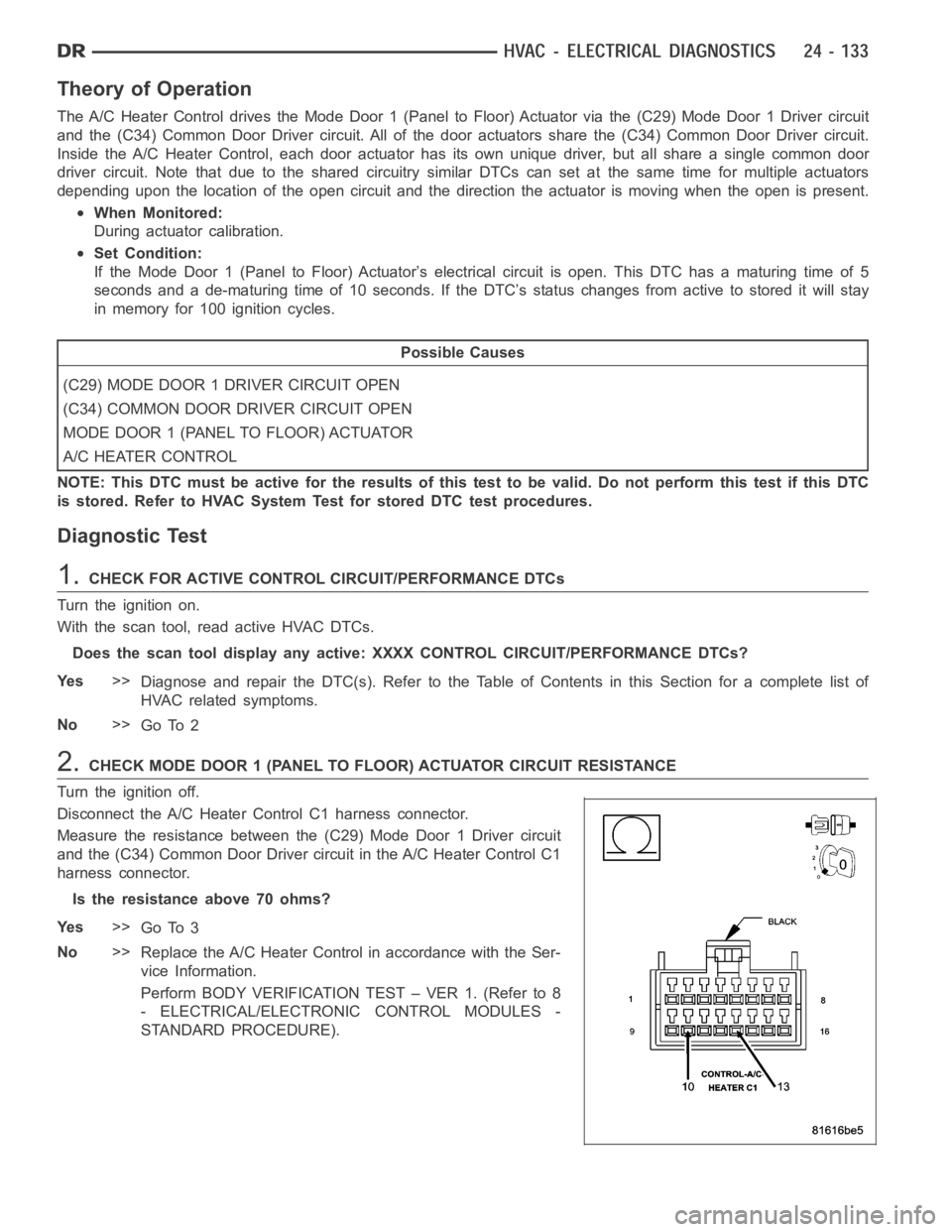
Theory of Operation
The A/C Heater Control drives the Mode Door 1 (Panel to Floor) Actuator via the (C29) Mode Door 1 Driver circuit
and the (C34) Common Door Driver circuit. All of the door actuators share the (C34) Common Door Driver circuit.
Inside the A/C Heater Control, each door actuator has its own unique driver, but all share a single common door
driver circuit. Note that due to the shared circuitry similar DTCs can set at the same time for multiple actuators
depending upon the location of the open circuit and the direction the actuator is moving when the open is present.
When Monitored:
During actuator calibration.
Set Condition:
If the Mode Door 1 (Panel to Floor) Actuator’s electrical circuit is open. This DTC has a maturing time of 5
seconds and a de-maturing time of 10 seconds. If the DTC’s status changes from active to stored it will stay
in memory for 100 ignition cycles.
Possible Causes
(C29) MODE DOOR 1 DRIVER CIRCUIT OPEN
(C34) COMMON DOOR DRIVER CIRCUIT OPEN
MODE DOOR 1 (PANEL TO FLOOR) ACTUATOR
A/C HEATER CONTROL
NOTE: This DTC must be active for the results of this test to be valid. Do not perform this test if this DTC
is stored. Refer to HVAC System Test for stored DTC test procedures.
Diagnostic Test
1.CHECK FOR ACTIVE CONTROL CIRCUIT/PERFORMANCE DTCs
Turn the ignition on.
With the scan tool, read active HVAC DTCs.
Does the scan tool display any active: XXXX CONTROL CIRCUIT/PERFORMANCE DTCs?
Ye s>>
Diagnose and repair the DTC(s). Refer to the Table of Contents in this Section for a complete list of
HVAC related symptoms.
No>>
Go To 2
2.CHECK MODE DOOR 1 (PANEL TO FLOOR) ACTUATOR CIRCUIT RESISTANCE
Turn the ignition off.
Disconnect the A/C Heater Control C1 harness connector.
Measure the resistance between the (C29) Mode Door 1 Driver circuit
and the (C34) Common Door Driver circuit in the A/C Heater Control C1
harness connector.
Is the resistance above 70 ohms?
Ye s>>
Go To 3
No>>
Replace the A/C Heater Control in accordance with the Ser-
vice Information.
Perform BODY VERIFICATION TEST – VER 1. (Refer to 8
- ELECTRICAL/ELECTRONIC CONTROL MODULES -
STANDARD PROCEDURE).
Page 4980 of 5267
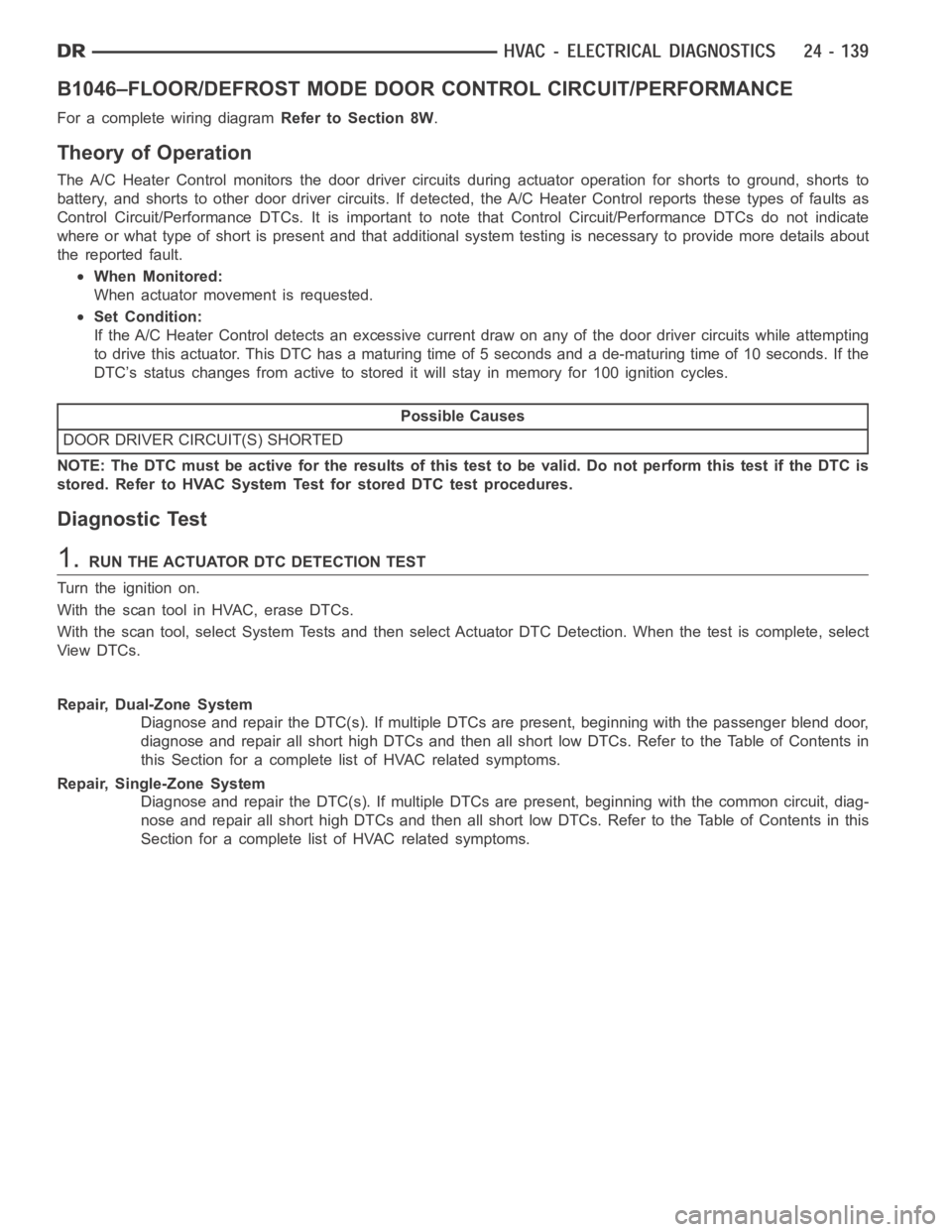
B1046–FLOOR/DEFROST MODE DOORCONTROL CIRCUIT/PERFORMANCE
For a complete wiring diagramRefer to Section 8W.
Theory of Operation
The A/C Heater Control monitors the door driver circuits during actuator operation for shorts to ground, shorts to
battery, and shorts to other door driver circuits. If detected, the A/C Heater Control reports these types of faults as
Control Circuit/Performance DTCs. It is important to note that Control Circuit/Performance DTCs do not indicate
where or what type of short is present and that additional system testing isnecessary to provide more details about
the reported fault.
When Monitored:
When actuator movement is requested.
Set Condition:
If the A/C Heater Control detects an excessive current draw on any of the door driver circuits while attempting
to drive this actuator. This DTC has a maturing time of 5 seconds and a de-maturing time of 10 seconds. If the
DTC’s status changes from active to stored it will stay in memory for 100 ignition cycles.
Possible Causes
DOOR DRIVER CIRCUIT(S) SHORTED
NOTE:TheDTCmustbeactivefortheresultsofthistesttobevalid.Donotperform this test if the DTC is
stored. Refer to HVAC System Test for stored DTC test procedures.
Diagnostic Test
1.RUN THE ACTUATOR DTC DETECTION TEST
Turn the ignition on.
With the scan tool in HVAC, erase DTCs.
With the scan tool, select System Tests and then select Actuator DTC Detection. When the test is complete, select
View DTCs.
Repair, Dual-Zone System
Diagnose and repair the DTC(s). If multiple DTCs are present, beginning with the passenger blend door,
diagnose and repair all short high DTCs and then all short low DTCs. Refer tothe Table of Contents in
this Section for a complete list of HVAC related symptoms.
Repair, Single-Zone System
Diagnose and repair the DTC(s). If multiple DTCs are present, beginning with the common circuit, diag-
nose and repair all short high DTCs and then all short low DTCs. Refer to the Table of Contents in this
Section for a complete list of HVAC related symptoms.
Page 4984 of 5267
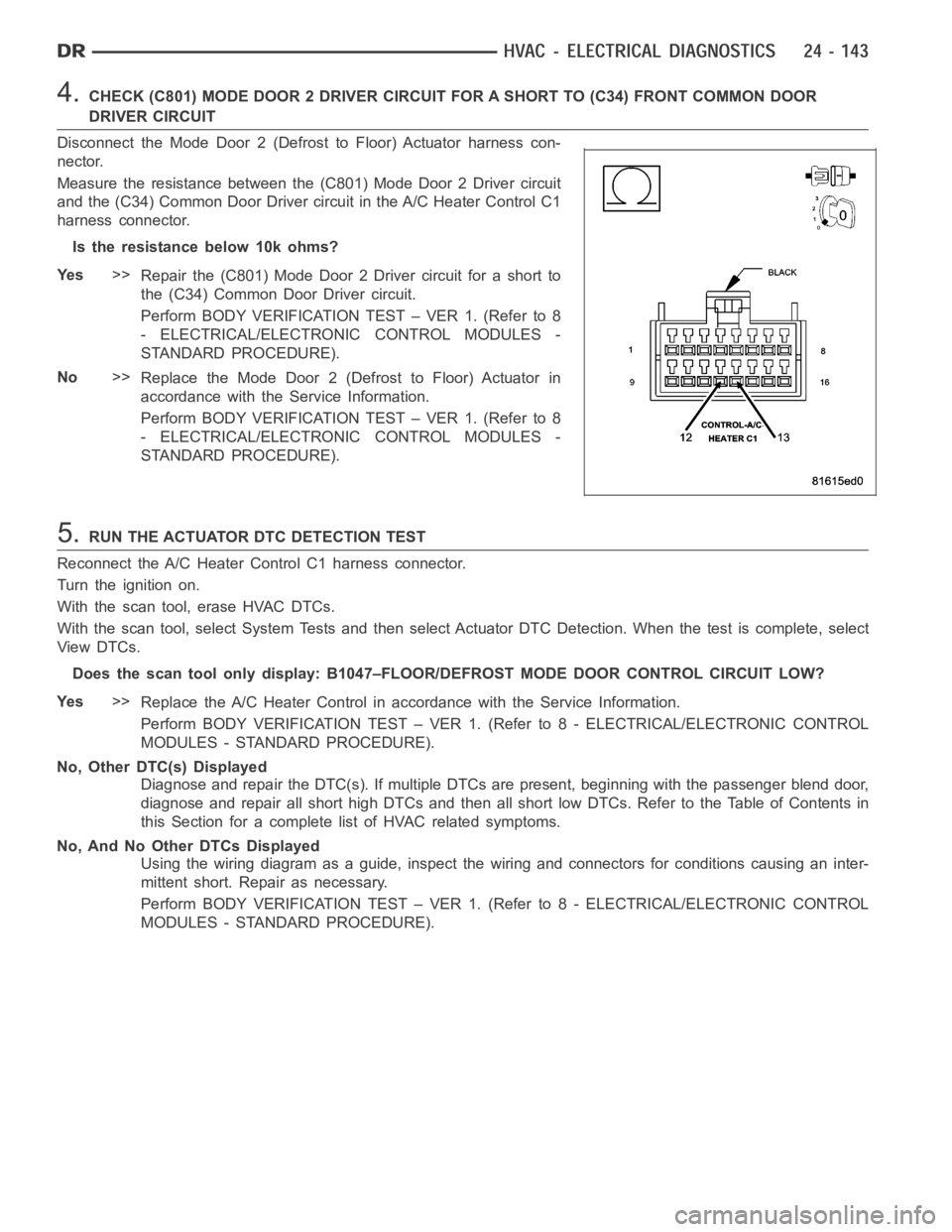
4.CHECK (C801) MODE DOOR 2 DRIVER CIRCUIT FOR A SHORT TO (C34) FRONT COMMON DOOR
DRIVER CIRCUIT
Disconnect the Mode Door 2 (Defrost to Floor) Actuator harness con-
nector.
Measure the resistance between the (C801) Mode Door 2 Driver circuit
and the (C34) Common Door Driver circuit in the A/C Heater Control C1
harness connector.
Istheresistancebelow10kohms?
Ye s>>
Repair the (C801) Mode Door 2 Driver circuit for a short to
the (C34) Common Door Driver circuit.
Perform BODY VERIFICATION TEST – VER 1. (Refer to 8
- ELECTRICAL/ELECTRONIC CONTROL MODULES -
STANDARD PROCEDURE).
No>>
Replace the Mode Door 2 (Defrost to Floor) Actuator in
accordance with the Service Information.
Perform BODY VERIFICATION TEST – VER 1. (Refer to 8
- ELECTRICAL/ELECTRONIC CONTROL MODULES -
STANDARD PROCEDURE).
5.RUN THE ACTUATOR DTC DETECTION TEST
Reconnect the A/C Heater Control C1 harness connector.
Turn the ignition on.
With the scan tool, erase HVAC DTCs.
With the scan tool, select System Tests and then select Actuator DTC Detection. When the test is complete, select
View DTCs.
Does the scan tool only display: B1047–FLOOR/DEFROST MODE DOOR CONTROL CIRCUIT LOW?
Ye s>>
Replace the A/C Heater Control in accordance with the Service Information.
Perform BODY VERIFICATION TEST – VER 1. (Refer to 8 - ELECTRICAL/ELECTRONIC CONTROL
MODULES - STANDARD PROCEDURE).
No, Other DTC(s) Displayed
Diagnose and repair the DTC(s). If multiple DTCs are present, beginning with the passenger blend door,
diagnose and repair all short high DTCs and then all short low DTCs. Refer tothe Table of Contents in
this Section for a complete list of HVAC related symptoms.
No, And No Other DTCs Displayed
Using the wiring diagram as a guide, inspect the wiring and connectors for conditions causing an inter-
mittent short. Repair as necessary.
Perform BODY VERIFICATION TEST – VER 1. (Refer to 8 - ELECTRICAL/ELECTRONIC CONTROL
MODULES - STANDARD PROCEDURE).
Page 4988 of 5267
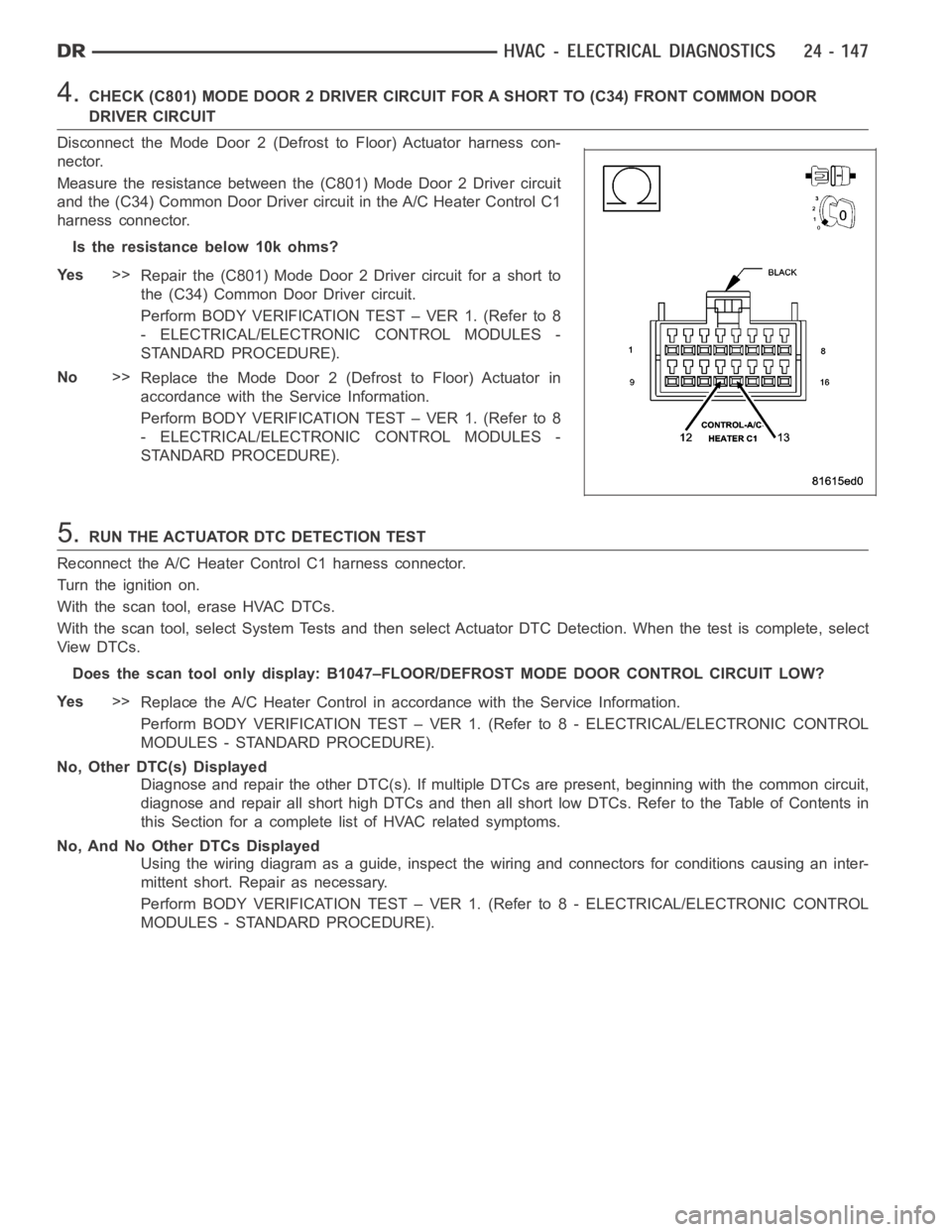
4.CHECK (C801) MODE DOOR 2 DRIVER CIRCUIT FOR A SHORT TO (C34) FRONT COMMON DOOR
DRIVER CIRCUIT
Disconnect the Mode Door 2 (Defrost to Floor) Actuator harness con-
nector.
Measure the resistance between the (C801) Mode Door 2 Driver circuit
and the (C34) Common Door Driver circuit in the A/C Heater Control C1
harness connector.
Istheresistancebelow10kohms?
Ye s>>
Repair the (C801) Mode Door 2 Driver circuit for a short to
the (C34) Common Door Driver circuit.
Perform BODY VERIFICATION TEST – VER 1. (Refer to 8
- ELECTRICAL/ELECTRONIC CONTROL MODULES -
STANDARD PROCEDURE).
No>>
Replace the Mode Door 2 (Defrost to Floor) Actuator in
accordance with the Service Information.
Perform BODY VERIFICATION TEST – VER 1. (Refer to 8
- ELECTRICAL/ELECTRONIC CONTROL MODULES -
STANDARD PROCEDURE).
5.RUN THE ACTUATOR DTC DETECTION TEST
Reconnect the A/C Heater Control C1 harness connector.
Turn the ignition on.
With the scan tool, erase HVAC DTCs.
With the scan tool, select System Tests and then select Actuator DTC Detection. When the test is complete, select
View DTCs.
Does the scan tool only display: B1047–FLOOR/DEFROST MODE DOOR CONTROL CIRCUIT LOW?
Ye s>>
Replace the A/C Heater Control in accordance with the Service Information.
Perform BODY VERIFICATION TEST – VER 1. (Refer to 8 - ELECTRICAL/ELECTRONIC CONTROL
MODULES - STANDARD PROCEDURE).
No, Other DTC(s) Displayed
Diagnose and repair the other DTC(s). If multiple DTCs are present, beginning with the common circuit,
diagnose and repair all short high DTCs and then all short low DTCs. Refer tothe Table of Contents in
this Section for a complete list of HVAC related symptoms.
No, And No Other DTCs Displayed
Using the wiring diagram as a guide, inspect the wiring and connectors for conditions causing an inter-
mittent short. Repair as necessary.
Perform BODY VERIFICATION TEST – VER 1. (Refer to 8 - ELECTRICAL/ELECTRONIC CONTROL
MODULES - STANDARD PROCEDURE).
Page 4990 of 5267
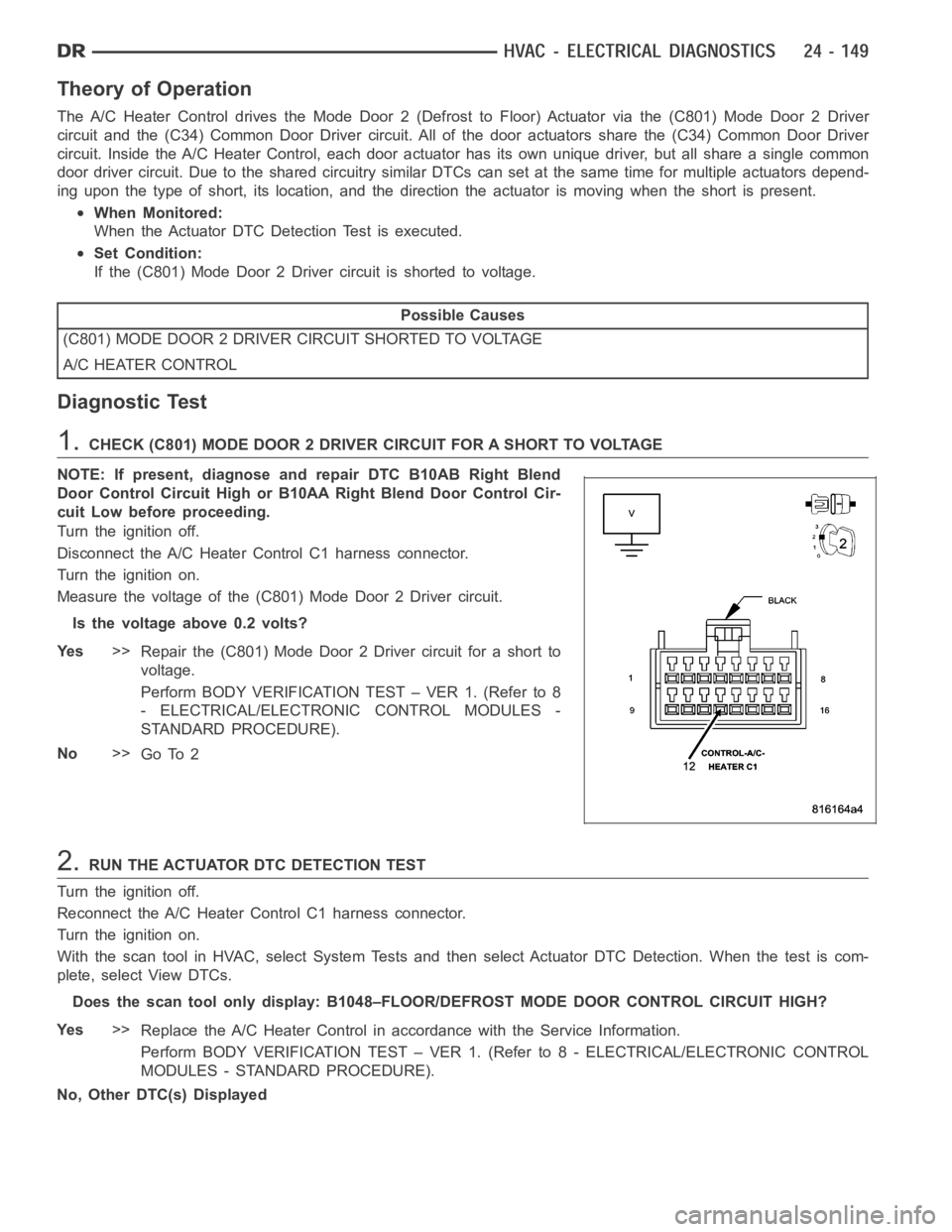
Theory of Operation
The A/C Heater Control drives the Mode Door 2 (Defrost to Floor) Actuator viathe(C801)ModeDoor2Driver
circuit and the (C34) Common Door Driver circuit. All of the door actuatorsshare the (C34) Common Door Driver
circuit. Inside the A/C Heater Control, each door actuator has its own unique driver, but all share a single common
door driver circuit. Due to the shared circuitry similar DTCs can set at thesame time for multiple actuators depend-
ing upon the type of short, its location, and the direction the actuator is moving when the short is present.
When Monitored:
When the Actuator DTC Detection Test is executed.
Set Condition:
If the (C801) Mode Door 2 Driver circuit is shorted to voltage.
Possible Causes
(C801) MODE DOOR 2 DRIVER CIRCUIT SHORTED TO VOLTAGE
A/C HEATER CONTROL
Diagnostic Test
1.CHECK (C801) MODE DOOR 2 DRIVER CIRCUIT FOR A SHORT TO VOLTAGE
NOTE: If present, diagnose and repair DTC B10AB Right Blend
Door Control Circuit High or B10AA Right Blend Door Control Cir-
cuit Low before proceeding.
Turn the ignition off.
Disconnect the A/C Heater Control C1 harness connector.
Turn the ignition on.
Measure the voltage of the (C801) Mode Door 2 Driver circuit.
Is the voltage above 0.2 volts?
Ye s>>
Repair the (C801) Mode Door 2 Driver circuit for a short to
voltage.
Perform BODY VERIFICATION TEST – VER 1. (Refer to 8
- ELECTRICAL/ELECTRONIC CONTROL MODULES -
STANDARD PROCEDURE).
No>>
Go To 2
2.RUN THE ACTUATOR DTC DETECTION TEST
Turn the ignition off.
Reconnect the A/C Heater Control C1 harness connector.
Turn the ignition on.
With the scan tool in HVAC, select System Tests and then select Actuator DTCDetection. When the test is com-
plete, select View DTCs.
Does the scan tool only display: B1048–FLOOR/DEFROST MODE DOOR CONTROL CIRCUIT HIGH?
Ye s>>
Replace the A/C Heater Control in accordance with the Service Information.
Perform BODY VERIFICATION TEST – VER 1. (Refer to 8 - ELECTRICAL/ELECTRONIC CONTROL
MODULES - STANDARD PROCEDURE).
No, Other DTC(s) Displayed